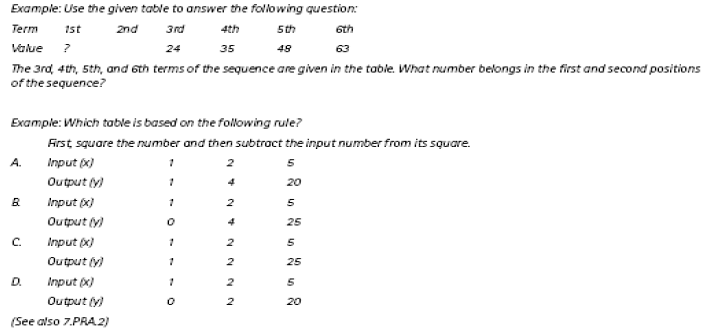Mathematics Entry Points of Grade 7
| Grade 7 | |||||||||||||||
| Learning Standards as written | Essential and Prioritized Skill | ||||||||||||||
| Number Sense and Operations |
7NSO-N1 | Compare, order, estimate, and
translate among integers, fractions, mixed numbers (i.e., rational numbers), decimals, and percents. |
♦ Compare, order, estimate and
translate integers, fractions, mixed numbers, decimals, and percents. |
||||||||||||
| Less Complex | Possible Entry Points | More Complex | |||||||||||||
| The student will:
♦ Define integers, fractions, |
The student will:
Using a number line: |
The student will:
♦ Compare and/or order integers, |
|||||||||||||
| Grade 7 | |||||||||||||||
| Learning Standards as written | Essential and Prioritized Skill | ||||||||||||||
| Number Sense and Operations |
7NSO-N7 | Apply number theory concepts,
including prime factorization and relatively prime numbers, to the solution of problems (e.g., find the prime factorization of whole numbers, and write the results using exponents: 24 = 2 x 2 x 2 x 3 = 23 x 3). |
♦ Use prime or composite numbers, factorization, greatest and least common multiples, or divisibility rules to solve problems. |
||||||||||||
| Less Complex | Possible Entry Points | More Complex | |||||||||||||
| The student will:
♦ Use models and/or |
The student will:
♦ Use a model to identify factors of two-digit |
The student will:
♦ Complete a factorization tree for two or
three-digit |
|||||||||||||
| General Education Examples | |||||||||||||||
 |
|||||||||||||||
| Grade 7 | |||||||||||||||
| Learning Standards as written | Essential and Prioritized Skills | ||||||||||||||
| Patterns, Relations, and Algebra |
7PRA1 | Extend, represent, analyze, and
generalize a variety of patterns with tables, graphs, words, and, when possible, symbolic expressions. Include arithmetic and geometric progressions (e.g., compounding) |
♦ Identify and extend a variety of grade-level patterns |
||||||||||||
| Less Complex | Possible Entry Points | More Complex | |||||||||||||
| The student will:
♦ Identify sets as patterns or non-patterns |
The student will:
♦ Match a pattern to its mathematical expression |
The student will:
♦ Extend a compounding pattern (e.g., 3, 5, |
|||||||||||||
| General Education Example
|
|||||||||||||||
| Grade 7 | |||||||||||||||
| Learning Standards as written | Essential and Prioritized Skills | ||||||||||||||
| Patterns, Relations, and Algebra |
7PRA3 | Use the correct order of operations
to evaluate expressions (e.g., 3(2x) = 5). |
♦ Use order of operations to solve an equation | ||||||||||||
| Less Complex | Possible Entry Points | More Complex | |||||||||||||
| The student will:
♦ List the sequence of the order of |
The student will:
♦ Solve a simple equation involving two or |
The student will:
♦ Use order of operations to solve an equation |
|||||||||||||
| General Education Example | |||||||||||||||
| Grade 7 | |||||||||||||||
| Learning Standards as written | Essential and Prioritized Skills | ||||||||||||||
| Patterns, Relations, and Algebra |
7PRA4 | Create and use symbolic expressions
for linear relationships, and relate them to verbal and graphical representations. |
♦ Use symbolic expressions for linear
relationships and relate them to graphic or verbal expressions. |
||||||||||||
| Less Complex | Possible Entry Points | More Complex | |||||||||||||
| The student will:
♦ Identify numbers in an |
The student will:
♦ Given verbal data represent the data in a |
The student will:
♦ Graph a set of ordered pairs |
|||||||||||||



